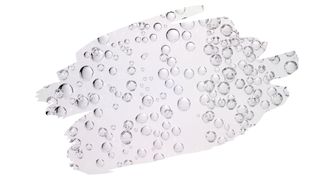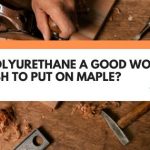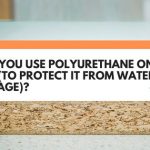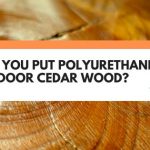It was all going so well.
You took the painstaking time to apply every coat of polyurethane. And you made sure to lightly sand between each coat to get that really smooth final finish.
But, now the final coat of polyurethane has dried and cured, things haven’t quite worked out the way you’d hoped.
Instead of a nice clear top coat, that polyurethane is filled with lots of tiny air bubbles — and they look like they’re there to stay.
So, where did things go wrong? And what can you do to fix it?
Well, in this post, you will learn the main key causes for air bubbles in polyurethane finishes. You will also learn what you can do to prevent those tiny bubbles from appearing in this otherwise smooth wood finish.
And keep reading to discover how to get rid of bubbles inside dried polyurethane.

This post may contain affiliate links to products that we receive a commission for (at no additional cost to you). Learn more here.
So What Causes Polyurethane Finish To Bubble?
Typically, those bubbles are caused by shaking that can of polyurethane. If you shake the can beforehand, you’ll create little air pockets throughout the liquid.
Another possible cause could be that the base coat underneath, (whether it be a finish, paint, wood stain etc), hasn’t cured yet.
As that base coat continues to dry and cure, it’ll release VOC’s. VOC’s (Volatile Organic Compounds) are the eye-watering fumes that waft off wood finishes.
And those VOC’s can become trapped as air bubbles (if you seal them in with polyurethane).
Yet another common cause for bubbles lies in improper brush prep. You always need to prepare your brush by rinsing it in solvents (or water) before you dip that brush into the polyurethane can.
Related Post: Can You Go Ahead And Coat Polyurethane Over Tacky Epoxy?
Will Those Polyurethane Air Bubbles Go Away On Their Own?
They should do. And as long as that polyurethane dries slowly enough, the bubbles will pop on their own.
This is one of the reasons why we typically add slow-drying thinner solvents to wood finishes. Thinning polyurethane out with these solvents can help slow down polyurethanes drying rate.
Related Post: Can You Really Go Mixing Stain With Polyurethane (For Hardwood Floors)?
OK. So What Can You Do To Avoid Air Bubbles Appearing On Polyurethane?
Simply follow best practice when it comes to applying any polyurethane finish:
1). Never Shake The Can
If that polyurethane finish has settled in the can, then stir it with a brush. Never ever shake the can.
2). Allow The Base Coat To Cure
This is particularly important if you’re applying polyurethane over slow drying finishes, such as Raw Linseed oil or Tung oil.
3). Prepare The Brush Before You Dip It In The Can
If you’re applying oil-based polyurethane: Dip the brush in a solvent, such as mineral spirits, before you dip it into oil-based polyurethane.
If you applying water-based polyurethane: Always dip the brush in fresh water, before you put it into that can of water-based polyurethane.
4). Skip Over Foam Brushes
Foam brushes are the worst culprits when it comes to creating air bubbles in thick wood finishes. So, only ever use a bristle brush (ideally) or even a rag to apply those thin coats of polyurethane.
Or, you can skip brush preparation altogether by using a Spray-on Polyurethane product instead.
Related Post: Are There Dust Nibs In Your Polyurethane Finish? (How To Fix It)
But How Do You Get Bubbles Out Of Already Dried Polyurethane?
In this case, you’ll need to sand those bubbles away.
The way you do this is by using 80-grit sandpaper to scuff off the sections that have bubbles. And then use 100-grit to 120-grit sandpaper to smooth the surface out afterward.
Once done, you can apply a new coat of polyurethane.
To Wrap Up, Here Are The 3 Key Takeaways From This Post…
- 1). Those little pockets of air throughout your polyurethane finish, can be caused by a range of different things. Everything, from improper brush preparation to polyurethane drying too fast, can create air bubbles in this wood finish.
- 2). If you are applying polyurethane over another wood finish, make sure the wood finish underneath has dried and cured first. If that base coat wood finish hasn’t cured, it may continue to release fumes. And those fumes can become trapped by that top coat of polyurethane as air bubbles.
- 3). If polyurethane has dried all the way through, but still has air bubbles in it, the only solution left is to sand those bubbles away. After sanding, you can reapply a fresh polyurethane coat.



